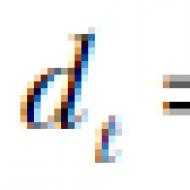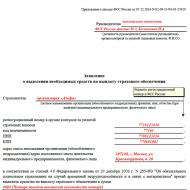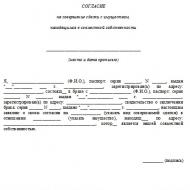
Casco for a credit car. Is it necessary to insure a credit car under comprehensive insurance for the second year? How are payments made under comprehensive insurance for a loan car?
In most cases, if you decide to take out a car loan from a bank, you will be faced with the need to purchase a CASCO insurance policy for credit car. On the one hand, these are additional costs for the borrower, who already bears costs in the form of interest on the loan. But on the other hand, CASCO for a credit car provides protection against risk financial losses, both the bank and the driver.
When concluding a loan agreement for the purchase of a car, the bank reserves the right to the car purchased by the borrower as collateral. This gives the bank a guarantee that the borrower will repay the loan regularly, because otherwise the borrower may be deprived of the car that was pledged as collateral. Naturally, the bank is interested in the safety of its property. After all, during operation, the car may get into an accident, or the car may be stolen. As a result, the value of the pledged property may greatly lose value or even be reduced to zero. And the borrower, in turn, will be left without a car and may lose the motivation to continue to regularly repay the loan.
In such conditions, mandatory CASCO insurance for a car loan is very beneficial to the bank, since it allows you to preserve the value of the pledged car even in the event of unforeseen circumstances: accident, theft, destruction, etc.
In turn, CASCO for credit cars is also beneficial for the driver. After all, in the event of an accident or theft, there is a risk of being left without a car and with outstanding loan, for which you are required to continue making contributions. CASCO allows you to avoid this risk of losing your car or additional costs for its repair.
Is CASCO mandatory for a credit car?
Although, in accordance with the legislation of the Russian Federation, only compulsory type of car insurance, most banks a necessary condition When obtaining a car loan, you put the purchase of CASCO on the loan car. This requirement is legal and by signing the loan agreement you agree to it.Of course, you can try to find a bank where CASCO is not required for a credit car. But here it is worth considering that usually the interest rate in such banks is significantly higher, and saving money with such a loan will be questionable.
As a rule, with a car loan it is necessary to purchase insurance policy full CASCO. That is, car insurance against the risks of damage, theft, theft and complete destruction, to the fullest. In this case, the sum insured must be , and the insurance policy is purchased for at least a year and usually without installment payments. After a year, it is necessary to renew CASCO insurance for the entire period loan repayments.
Of course, such strict conditions deprive drivers of the opportunity to take advantage of the many benefits that insurance companies now offer in abundance.
How are CASCO payments made for a loan car?
A CASCO agreement for a credit car is a tripartite agreement between the borrower, the bank and the insurance company. In case of insured event there may be several payment options insurance compensation.First option– the beneficiary in any insured event is the bank. That is, in the event of theft, accident or destruction of the car, the insured amount is transferred to the bank, and from there the money is transferred to the borrower to restore the loss. At the same time, the period for receiving money increases, because in addition to the standard procedure for compensation for damage from the insurance company, the borrower also has to wait for a transfer from the bank. In addition to this inconvenience, there are known complaints from clients of unscrupulous banks who reduced the amount of insurance payments, delayed them or refused to pay them.
Second option– beneficiary in case of theft, theft and death vehicle is the bank, and in case of damage – the borrower. Moreover, in cases where the beneficiary is a bank, the entire amount of insurance compensation is transferred to it. This is already more convenient option for the driver. In the event of an accident, there is no need to wait for funds to be transferred through the bank. Bank in in this case is insured only against large losses in order to, if necessary, repay the loan unpaid by the borrower.
Third option– the beneficiary in case of damage is the borrower, and in case of theft, theft and destruction of the vehicle – the bank. But only for the amount of the loan outstanding by the borrower. The rest of the insurance payment goes to the borrower. That is, for example, if a borrower’s credit car worth 700,000 rubles was stolen, and the outstanding balance on the loan is 300,000 rubles, then a jar will do only 300,000. The difference between the cost of the car and the loan balance will go to the borrower, i.e. 400,000 rubles. This option is the safest for the driver. It allows you to protect yourself from the possibility of being left without a car and without the money already spent on repaying the loan.
It is best to ensure that this condition of insurance payments is specified in the insurance contract for a credit car.
How to choose an insurance company for CASCO for a credit car?
Almost all banks recommend concluding an insurance agreement with companies accredited by the bank for a car loan, i.e. with whom the bank has an agreement and who meet the bank’s requirements.For reputable, reliable banks, this list is quite extensive and includes almost all the most well-known ones, among which you can choose for yourself the most advantageous offer for CASCO insurance for a credit car. In this case, there is little point in refusing companies from this list; you will simply lose more time.
But in some cases, this list may contain only a few companies that also have a CASCO policy. In this case, it makes sense to abandon the list of accredited insurance companies.
In any case, you have the right to choose yourself insurance company. The main condition for this is that the insurance company meets the bank’s requirements. You have the right to request these requirements from the bank itself, then collect all the necessary documents from the insurance company you are interested in and take them to the bank.
If the bank still denies you your right to choose an insurance company, although it meets all the requirements, you can safely defend your rights, even going as far as contacting Rospotrebnadzor and filing a lawsuit.
It is also better to take into account one more point when choosing insurance. Some companies may inflate the cost of an insurance policy specifically for credit cars, since usually accredited companies give a certain percentage of money to the bank for each client. Although such actions are illegal and reputable insurance companies are unlikely to do this, it is still better to compare the cost of a policy for a credit car and for a car you purchase yourself.
How can you save on CASCO with a loan?
Although the conditions for CASCO for a credit car are usually quite strict, there are still some ways to reduce the cost of an insurance policy.Insurance CASCO for the residual value of the loan. In this case, you insure the car not for its market value, but for the amount that you still have to pay to the bank. This can significantly reduce the cost of the CASCO policy, but in the event of theft or destruction of the car, only the bank will receive insurance compensation.
Franchise. CASCO with a franchise for a car loan is not allowed by all banks. Only some offer the possibility of a small deductible when purchasing a CASCO policy. A deductible can significantly reduce the cost of the policy, but it should be noted that the driver will have to pay some of the damage to the car himself. For example, with a deductible of 5,000 rubles, the insurance company will pay the amount of compensation for damage minus 5,000. That is, for damage of 30,000 rubles, only 25,000, for damage of 45,000, only 40,000, etc.
CASCO for the second year with a car loan
In some cases, with a car loan, the bank may offer you CASCO insurance for the entire loan term. This may have a number of disadvantages for the borrower:Firstly- change every year, and the price of the policy may decrease, in addition, the estimated value of the car decreases every year, and this may not be taken into account in the policy.
Secondly- you can repay the loan early, and miss the opportunity not to insure the car for the rest of the term or take advantage of more profitable programs CASCO.
Third- in the case of break-even driving, insurance companies usually make significant discounts for each year, which are usually not taken into account when purchasing a policy for the entire term of loan repayment.
In most cases, it is still better to buy a CASCO policy for a credit car for a year, and then renew it. However, you can change your insurance company after a year. If, for example, you are not satisfied with the company’s tariff for this year, and you found a better offer from another insurance company.
How to refuse a CASCO policy imposed by a bank
IN last years cases of imposing “unnecessary” insurance when purchasing CASCO policies, concluding credit agreements and car loan. This circumstance caused dissatisfaction among citizens. The CASCO policy has already become an expensive “pleasure”; in order to get a car loan, according to the bank’s conditions, you need to purchase a CASCO policy.From January 1, 2018, insurance buyers have the opportunity to refuse unnecessary services using the so-called “cooling off period.”
If the Insured refuses - individual from the insurance contract upon expiration of the Cooling Period, early termination of the insurance contract is carried out in accordance with Art. 958 Civil Code of the Russian Federation.
Be careful if you want to refuse additional CASCO insurance, which is often offered along with a car loan; with the help of such insurance, the bank reduces its risks, and this gives it the opportunity to offer you more profitable terms lending.
Therefore, your contract may stipulate that if you refuse additional insurance, even during the “cooling period,” the interest rate on the loan will increase or penalties will be charged or the loan agreement may even be terminated in court. You can read more about the cooling period
In the vast majority of cases, banks issue a positive decision on a loan for the purchase of a vehicle only when applying for CASCO insurance, and some also require that a life insurance agreement be concluded. For a borrower of a credit institution, it is obvious that insurance is just an imposed additional expenses, and therefore he reasonably has a question - why take out this policy, and what consequences may arise if you refuse it? In this article we will try to thoroughly understand the nuances of applying for CASCO for a credit car - in which cases it is necessary and in which it is not.
Why take out a CASCO policy for a car loan?
Taking out an insurance policy, first of all, is beneficial to the bank issuing the loan - in this case, the policy is a guarantee against various kinds of troubles, which include the borrower losing a job or being unable to work, getting a car into an accident, and other cases. Bankers do not want to risk their money and force borrowers to agree to their terms, thereby guaranteeing the return of their funds if the car is stolen or irreparable damage is caused to it during the loan period.
According to the terms of the agreement, the purchased vehicle is the property of the bank until the end of the lending period. As a result, the bank is interested in the safety of the collateral property and, in order to minimize risks, forces borrowers to take out CASCO insurance, which will reimburse all losses in the event of an insured event.
However, the borrower, who is the loan originator, also receives a number of benefits from taking out a CASCO policy:
- the bank rate on a loan with CASCO insurance is usually lower than without a policy;
- compensation for damage in the amount of car repairs upon the occurrence of an insured event;
- full repayment of the loan by the insurance company in the event of theft or destruction of the car.
The purchased policy allows you to provide all the benefits only if it was issued by a reliable company. Most banks, when requiring CASCO registration for a car loan, strongly recommend concluding insurance contracts with accredited companies. If the conditions offered by these insurers do not suit the client, then he has the opportunity to independently choose a company - but in this case, the requirements of the bank and the insurance company for the collateral must coincide.
Bank's position in case of destruction or theft of vehicles
In the event of any of the possible insurance situations, except for the destruction or theft of the car, the owner receives payments under the insurance contract. If the car was stolen or cannot be restored, then the payment, in accordance with the CASCO agreement, will be received by the creditor bank.
Future owners of credit cars quite often face the registration problem described above. loan agreement. Its essence lies in the fact that it is not always possible to understand the relationship between banks and insurance companies.
Many financial organizations In order to attract customers, they pursue a policy of so-called “cheap loans”. But this, as a rule, hides very strict terms of the contract, in which one of the mandatory clauses states the requirement to purchase a full CASCO insurance for the entire loan period. In this case, the choice of an insurance company is regulated by the bank. To avoid such situations, it is advisable to start by searching for an insurer who will help you choose the most appropriate option for purchasing a CASCO policy for a credit car, and a bank with optimal conditions credit program. This will protect potential car loan clients from bank surprises.
The procedure for obtaining CASCO insurance for a credit car
Having decided to buy a car on credit, you need to take care of choosing a reputable and reliable insurance company. If the borrower has no preference in choosing one company or another, then in this case it is better to use the bank’s list of accredited insurance companies. When applying for CASCO insurance for a credit car, the insurer must inform the client about the features of the transaction being concluded and the package necessary documents. As a rule, the standard package of documents includes:
- a written statement on the form of the insurance company. It contains reliable information about the future owner of the vehicle and drivers who may be allowed to drive it;
- car owner's passport;
- driver's licenses all persons mentioned in the application;
- vehicle registration certificate issued upon purchase;
- registration certificate received from the State Traffic Inspectorate.
In some cases, the list of basic documents may be expanded and the owner will also have to provide the following official papers:
- a notarized power of attorney confirming the right to operate the insured vehicle. This document is required if the policyholder is not the owner, but the driver;
- check or invoice issued when purchasing a car;
- bank loan agreement;
- an appraisal document confirming the value of the car if it is purchased at secondary market;
- document confirming passing a technical inspection or diagnostic card;
- certificate of registration of the organization if the car is purchased on credit for a legal entity;
- in case of using additional equipment installed on the machine, it is necessary to document its cost.
After completing the entire package of necessary documents, representatives of the credit institution and the insurer set a date for inspecting the vehicle in order to confirm the accuracy of the information provided and identify possible damage. After completing all procedures, the drawn up insurance contract is signed. It very clearly records the following information:
- information about the owner of the car;
- the number of drivers allowed to drive and information about them;
- availability of additional equipment;
- bank interest rate;
- terms of the signed contract;
- a list of insured events with their full description.
After this, payment for the policy is made, insurance is issued, additional documents are issued, including the rules of insurance in this company and a receipt for payment for services.
Standard conditions for issuing CASCO insurance for a car loan
The conditions for drawing up a CASCO agreement for a car loan may differ significantly from case to case. The most common car insurance conditions when concluding a loan agreement are listed below:
- Registration of full CASCO. Since the creditor bank is actually considered the owner of the car until the cost is paid in full, it evaluates absolutely all the risks associated with its operation, the list of which includes breakdown, damage, theft and others. Therefore, purchasing a full CASCO package is one of the main requirements when receiving bank loan for the purchase of vehicles.
- Registration of CASCO insurance for the loan period. This condition assumes that the borrower must annually, during the term of the loan agreement, take out a CASCO insurance policy for the vehicle on the loan. If the borrower pays early full cost car to the bank, he has the right to refuse insurance or arrange it at his own discretion. If the full amount of the loan is not paid by the borrower, but he refused to take out a CASCO policy, then such actions may be regarded as a violation credit conditions agreement. On the part of the bank, this will entail penalties, up to judicial procedures and requirements for early loan repayment.
The insured and the “beneficiary” - who receives the payment?
The CASCO insurance contract uses such concepts as policyholder, owner and beneficiary. The essence of these terms is as follows:
- policyholder – the person taking out insurance;
- owner - the one who took out a loan to purchase a vehicle, that is, the car owner;
- beneficiary – the recipient of the insured amount if the car is stolen or damaged.
Logically, the owner and the policyholder are the same person who purchased the car on credit and took out insurance. The role of the beneficiary in this scheme belongs to the bank, and it is he who will receive the payment upon the occurrence of an insured event. After all before full repayment loan, the vehicle is collateral and cannot be considered the full property of the borrower. This requirement is basic for obtaining the required loan amount.
In fact, this means that if the car is destroyed or stolen, the bank will reimburse the unpaid loan, and the policyholder (borrower) can receive the remaining money. It should not be forgotten that the amount specified in the CASCO agreement must be equal to market value vehicle at the time of insurance registration . This will be a sufficient guarantee of damages for both parties.
Here are a few examples that reveal in more detail the essence of the concept of “beneficiary” in specific situations.
Example 1. A loan car was stolen a short period of time after the loan agreement was drawn up and the insurance agreement was concluded. In this case, the bank will receive the entire amount from the insurance company, minus the client’s first payment, and the owner of the vehicle (borrower) will fully return the first payment paid. In this case, the beneficiary is undoubtedly the bank.
Example 2. If the same situation occurs, but occurs at the stage of almost full repayment of the loan, the borrower will receive under the insurance policy the part of the funds due to him, which will more than the amount received by the bank. In this case, the main beneficiary will be the owner of the car. The amount received will allow him to purchase, if desired, more cheap car and cover the costs incurred.
Quite often, responsible beneficiary banks issue powers of attorney to their clients to carry out repair work in the event of damage under CASCO. They do not deal with such miniscule losses, from the point of view of banks, and leave these issues to the borrowers to resolve.
Thus, summarizing the theses described above, we can draw the following conclusion:
When concluding an agreement, it is imperative to understand in detail the mechanism of the relationship between the bank, the company providing the service, and the policyholder. It is desirable that the CASCO agreement clearly stipulates the terms of mutual settlement between all parties involved in the event of damage, destruction or theft of the vehicle. In any case, in the agreement the bank must take into account not only its own interests, but also the interests of its clients.
Cost of CASCO for a credit car
When applying for CASCO insurance for a credit car, another obvious question of interest to the borrower is the cost of this insurance program. The fact is that insurance companies have special conditions for insuring credit cars, and estimating the cost of such a policy using a standard calculator can be quite problematic. The CASCO formula for a credit car takes into account a large number of parameters and coefficients, the value of which is set by the insurance company, but in most cases the CASCO insurance rate varies from 5 to 10% of total amount loan. The cost of each policy is calculated individually, since its value is influenced by the following aspects:
- car model and make;
- age and driving experience of the policyholder;
- mileage and age of the vehicle;
- car value assessment;
- availability of a car loan;
- insurance cases, their number and other options.
In addition to the main factors, some subjective characteristics can also be taken into account, such as the country of origin of the car, a new or used car, the class of the car and the theft rate of such vehicles. It may seem surprising, but cars manufactured in China have the highest insurance rates.
Below is a comparison of CASCO insurance rates in Moscow for a VOLVO – V60, produced in 2016, obtained using insurance calculator(engine power - 150 hp; cost of the car - 1,745,000 rubles; driver - 1, his age - 30 years and driving experience - 3 years; start date of operation - 09/10/2016).
| Insurance Company |
Tariff, % |
Cost of the policy, rub. |
|---|---|---|
| Ingosstrakh |
1,71
|
29 780,00
|
| Rosgosstrakh |
2,42
|
42 229,00
|
| Tinkoff Insurance |
2,92
|
50 929,50
|
| Agreement |
3,23
|
56 314,50
|
| MAX |
3,28
|
57 236,00
|
| Renaissance |
4,09
|
71 457,00
|
| Rosmed |
5,48
|
95 626,00
|
| Itil |
5,82
|
101 559,00
|
| Hayde |
6,25
|
109 037,00
|
| Liberty |
7,36
|
128 380,00
|
| RESO-Garantiya |
7,83
|
136 569,00
|
| Ergo |
10,10
|
176 245,00
|
| AlfaInsurance |
12,02
|
209 678,00
|
From the table above we can conclude that the cost of a CASCO policy in different insurance companies can differ by almost 10 times! That is why, when purchasing a vehicle on credit, you should be especially careful when choosing a bank and insurance company, and pay attention to the following aspects.
Looking at the stream of sparkling new foreign cars, I remember the famous humorist’s saying: “Show me your car, and I’ll tell you how much money you owe the bank!” Russia is experiencing a real boom in car lending, which has given rise to such a phenomenon as “forced” insurance, which is mandatory when issuing a loan. Indeed, most banks stipulate in the loan agreement the need for the borrower to insure the car against damage and theft under CASCO, as well as sometimes other risks.
It would seem that insurance is a great way to protect your property and yourself from unpleasant accidents. However, if you buy an insurance policy when applying for a loan, this does not always mean that you are providing insurance protection for yourself. Let's consider all the nuances and pitfalls of insurance when applying for a car loan.
What risks do “bank insurance policies” protect against?
What are the main reasons that force a bank to require its client to take out insurance? This is by no means a concern for the well-being and protection of the borrower. The bank takes care of itself first and foremost. Every credit institution is faced with the phenomenon of non-repayment of loans and late payments. To protect itself as much as possible, the bank makes full use of insurance opportunities. Several years ago, during the birth period consumer lending In Russia, insurance of banks against loan defaults was in great demand. However, very soon this type insurance has proven itself to be highly unprofitable and impractical for insurance companies, forcing them to abandon its use. Having lost such convenient support, banks came up with several more good options for protecting against obligations not fulfilled by borrowers. Loan agreements today may provide for compulsory insurance of several types:
Insurance of a car purchased with credit funds under CASCO against the risks of “Theft” and “Damage”
One of the conditions for obtaining a car loan is the transfer of a vehicle purchased with the bank’s money to the bank as collateral until the funds are fully returned. In case of non-payment of loan installments, the bank has the right to take the car for sale to pay off the debt. However, an expensive car is not a very reliable collateral, since it can be stolen or damaged in an accident. If such a sad event occurs, the bank will have nothing to compensate for the amount of the loan issued. The borrower, having lost his car or received a car after a serious accident that requires overhaul, will be very reluctant to repay the loan. That is why the bank insists on mandatory insurance of the collateral subject to full CASCO insurance against the risks of “Damage” and “Theft”.
OSAGO insurance
Despite the fact that compulsory motor liability insurance is mandatory for all car owners and is regulated by the state, the creditor bank dictates its terms here too. Most often we are talking about specific policy validity periods, which usually must coincide with the date of the CASCO policy and the date the loan was issued. In addition, the bank prohibits insuring under compulsory motor liability insurance in installments, and making the policy open, providing for an unlimited number of persons allowed to manage it. Often, the lists of drivers in CASCO and MTPL policies must be completely identical.
DOSAGO insurance
Often the bank obliges the borrower to purchase a policy Voluntary insurance motor vehicle liability. It will protect if the insured amount provided for by the contract OSAGO will not be enough to cover expenses after an accident due to the fault of the borrower. As a rule, the bank independently sets the amount for which DOSAGO should be insured.
Accident insurance
Some banks go even further in their prudence. If the loan amount is large enough and the borrower’s age exceeds 45-50 years, the bank may require him to insure against accidents against the risks of “death”, “disability”, as well as “permanent” and sometimes “temporary disability” "
A number of commercial banks make accident insurance a mandatory condition for issuing a car loan. Insurance should help pay off the loan if an accident occurs to the borrower, which jeopardizes his ability to do it himself. Requirements for an accident insurance contract may vary. Some banks ask the borrower to insure his life and health for the time when the borrower drives a car purchased on credit. Such insurance is inexpensive and is most often included in a combined voluntary auto insurance contract. However, cases of compulsory accident insurance with insurance coverage “24 hours a day” are not uncommon. The cost of such a policy can reach several tens of thousands of rubles.
A number of commercial banks make accident insurance a mandatory condition for issuing a car loan. Insurance should help pay off the loan if an accident occurs to the borrower, which jeopardizes his ability to do it himself.
Requirements for an accident insurance contract may vary. Some banks ask the borrower to insure his life and health for the time when the borrower drives a car purchased on credit. Such insurance is inexpensive and is most often included in a combined voluntary auto insurance contract. However, cases of compulsory accident insurance with insurance coverage “24 hours a day” are not uncommon. The cost of such a policy can reach several tens of thousands of rubles.
The fact is that personal insurance rates depend on the age, gender and health status of the insured person. So, for example, a 50-year-old man with chronic disease can receive a tariff of 6-7% of the sum insured for insurance from NS. Which is, in principle, equivalent to the cost of CASCO insurance. But it is important to remember that the requirement to insure under the National Tax Service is illegal if the bank refuses to issue a loan without such a service. The bank has the right to increase the loan rate for clients who are not insured under the National Insurance (and this increase should not be discriminatory), but does not have the right to refuse to issue a loan due to the lack of insurance against the National Insurance.
Who does collateral insurance protect?
Having insured the full program and fulfilled all the bank’s conditions, there is no time for the borrower to relax. To understand how useful the insurance terms are for you, carefully study the insurance documents.
The main point that should interest you is the information about the beneficiary specified in the insurance policy and other documents received from the insurer.
Most often, the full legal name of the creditor bank will be indicated here, without any notes. In this case, the insurer must transfer all payments for insured events to the bank. That is, in essence, this insurance option assumes that, at your own expense, you insure, first of all, the bank’s risks. And the amount of compensation for an insured event will depend only on the honesty and integrity of the bank. In this case, the policyholder has no confidence that the payment will be credited to repay the loan or will be given to him for car repairs. The bank has the right to use the received payment at its discretion. Of course, in the vast majority of cases, credit institutions do not use this “loophole,” but if the bank that issued you the loan does not inspire confidence, such a “loophole” may subsequently become a problem.
A more reliable option for the borrower is when the insurance contract states that for the risks “Theft”, “Theft” and “Full constructive failure TS" the beneficiary is the bank, and in other cases - the policyholder. This wording means that all insured events under the “Damage” risk with damage up to 60-85% of the actual cost of the car will be used to restore the collateral to the bus station, or to the insured to restore the collateral.
As was written above, normal creditor banks, even if the bank agreement indicates the bank as the sole beneficiary, do not take the money for themselves, but give it to car repairs. In practice, this process looks like this: the client contacts the insurer with a claim about an insured event. The insurer reviews the documents, draws attention to the fact that the beneficiary - the bank, receives a report on the assessment of the cost of restoration repairs. Next, the insurer prepares a letter to the bank with a request to explain in writing to the insurer what to do with the compensation and where to transfer it, since he is the beneficiary under the contract. There are several possible answers from the bank:
- The bank asks the insurance company to transfer the payment to the client’s account to repay his debt on the loan.
- The bank asks the insurance company to dispose of the compensation at the discretion of the policyholder. This type of response most often comes from the bank if the borrower regularly makes payments on the loan. This option for disposing of the insurance payment is more profitable for the bank, since it will receive a restored collateral and a loyal client who is ready for further payment of the loan and interest.
It is also important to pay attention to one more nuance. In insurance policies concluded at the request of the bank, in the section on the beneficiary or in special conditions, an entry must be made that payments are transferred to the bank in the part outstanding credit debt the policyholder. The difference between the payment amount and the borrower's debt on the loan in this case is paid to the policyholder. The absence of a record leaves hope only for the integrity and honesty of the bank, which will consider it necessary to give the difference to the borrower. Unfortunately, this does not always happen.
Risks of insurance at the request of the lending bank
In addition to all of the above, a car loan borrower should remember the following:
- In most cases, insurance is mandatory.
The borrower usually has no choice here whether to insure or not, and there is no opportunity to save on unnecessary insurance when he is confident in his driving skills. Although, to be more precise, there is always a choice, but those car loan programs that allow the borrower not to insure usually cost an order of magnitude more than the policy, which automatically makes them unprofitable. - The insured amount is determined by the bank.
Most often, the borrower does not have the right to establish insurance amount under insurance contracts yourself and save on this by choosing incomplete property insurance (i.e., for example, indicating the cost of a car is 800,000 rubles, instead of 1,000,000, as the bank wants, it will not work). This point is ambiguous, since savings from understating the insured amount will also affect subsequent payments, which will be calculated as the ratio of the insured amount to the insured value. When taking a car loan, the bank usually requires you to insure the car for its actual value, and when insuring against an accident insurance cover will be equal to the amount of credit debt and the annual interest rate. - A CASCO insurance policy for credit cars may cost more.
As a rule, tariff rates for insuring credit cars are higher than for vehicles purchased by the policyholder independently. The fact is that insurance is included in the cost of insurance " bank client» the amount of commission to the bank, brokers and agents, which the borrower will have to pay. Typically, an agency agreement is signed between the bank and the insurance company, in which the bank acts as an agent for attracting clients to the insurance company. Often the lender's agency fee is 35-40% of the amount you will pay for insurance. In addition to official contracts, the commission goes to unofficial payment for the services of credit agents, who unobtrusively recommend a certain company to the borrower. It is worth noting that inflating tariff rates for insuring “credit” cars is absolutely illegal and violates the “Law on the Protection of Consumer Rights.” The Federal Antimonopoly Service closely monitors the activities of banks and insurance companies in this area. Each case of borrowers filing complaints with the FAS is considered and serves as the basis for gradually changing the current situation for the better. Thus, several years ago, the Rostov Department of the FAS revealed cases of differences in tariff rates for the same types of insurance by 30%, which was the result of illegal agreements between banks and insurers. FAS was involved in the activities of insurance companies and banks and forced them to eliminate the violation that had taken place. Unfortunately, the Russian mentality does not allow the majority of citizens to protest against the sometimes predatory conditions of credit institutions. However, remember that in this case the law is on your side, but you will need to prove your case with documents. - Prohibition on installment insurance.
The bank may prohibit borrowers from splitting the annual insurance premium into payments. The credit department will ask you to show the original receipt of payment of the full cost of the policies for the year. This approach is not always convenient for the policyholder. - Extension of insurance contracts is necessary until loan obligations are fully fulfilled.
Every year, until you fully pay off the car loan with the bank, it will oblige you to take out insurance. - The list of insurance companies that are bank partners may be very limited.
Having issued a loan, the bank may deprive you of your freedom of choice when searching for the best insurance company. The bank will provide you with a list of insurers accredited by this institution. This list, sometimes consisting of two or three companies, will reflect not your opinion, but the bank’s opinion regarding the best and most convenient insurance conditions. They will not accept an insurance policy from a “foreign” company, forcing you to take reinsurance or denying you a loan. Imposing certain insurance companies on borrowers is contrary antimonopoly legislation. FAS monitors the terms of cooperation agreements between banks and insurers, and also responds to complaints from borrowers and policyholders. The FAS often initiates cases against banks for imposing insurance companies. You can protect your rights if you contact the FAS, but you still have to prove your case.
- Read the insurance contract carefully.
Only a detailed and detailed study of insurance documentation will allow you to avoid extortionate insurance conditions. Ask SK full package documents – insurance rules, policy, special conditions, if they are provided. Request clarification of unclear points from competent employees. Don't sign the contract in a hurry. - If you are going to buy a policy at a bank or salon, first find out the cost of insurance yourself.
Often, at the car dealership where you purchase a car, and at the bank where you sign a loan agreement, friendly agents from insurance companies from the bank’s list are on duty. When offering you insurance here and now, they will talk about convenience, saving time and the need to be insured before leaving the salon. However, their words are not always true. Usually the price of a policy from an insurer's agent is very high, since it includes his earnings, which he does not want to lose even partially. True, completely opposite cases are also known, when insurance in car dealerships becomes the most the best option. This situation is possible if the salon has its own insurance department, in which policies are issued by the salon’s full-time employees. In this case, insurance is related service when buying a car, organized with the aim of increasing sales of the cars themselves. In this case, “salesmen” of insurance services are not motivated by agency fees. The salon, in turn, making excellent money from selling cars, can afford to completely waive the insurer's commission in order to attract a buyer. In addition, one of the conditions of a cheap policy purchased at a salon may be to receive insurance payments only through repairs at the service station of the salon itself (official dealer). For a client who bought a brand new car, this point may not be significant, since vehicles under warranty are most often repaired in this way. At the same time, the salon gets the opportunity to earn money in the future through payments from the insurance company for repairs and that is why it is so willing to give discounts on insurance. Be that as it may, study everything carefully possible options purchasing a policy. Remember that it is possible to issue a policy in advance under the title and loan agreement, showing the car for inspection a little later. In addition, you can calculate the cost of insurance on the Internet, for example using the CASCO calculator. - Study in detail all offers of the lending and insurance market.
Typically, each bank has a very small list of accredited insurers with very high rates. However, large insurance companies cooperate with many banks. Inquire in advance not only about the terms of the loan, but also about the insurance options. Try to read
Buying a vehicle on credit is a fairly profitable enterprise. After all, by paying the bank a “modest” interest, you get the opportunity to use the car even before the debt to the bank is fully repaid. But it's not that simple. Credit organisation is obliged to insure its possible losses. On what basis is the conclusion of the contract CASCO for car loans is a prerequisite. But not all consumers know how to make cooperation with a bank and insurance company beneficial for all parties.
With whom to conclude a CASCO agreement for a credit car?
Having visited a car dealership and made a choice, the buyer may not even realize that the contract CASCO for credit vehicle You can conclude not only through the bank, but also in accordance with your preferences. The main nuance in this matter is the attractive interest rate that car dealerships lure buyers with. What is the secret of such loyalty? Let's figure it out together.
Typically, vehicle dealers act as follows: they offer the client especially favorable conditions - minimum an initial fee, long loan term, low interest rates, acceptable monthly payment. Well, how can you refuse this? But life teaches us that in everything that is very cheap, there is some kind of catch. So it is here. Usually, upon receiving such advantageous offer conclusion is a prerequisite CASCO when drawing up a loan agreement.
You will not be able to choose the risks against which you will be insured. Such agreements provide complete protection against theft, complete destruction and various types of damage. Moreover, the cost of such pleasure cannot be called affordable for everyone. Therefore, many potential clients prefer to refuse to purchase a new car, or postpone it indefinitely.
A special nuance of the acquisition CASCO on credit is that you will not be given the opportunity to make an independent choice of which insurer to cooperate with. When you sign up for a contract, you will be offered several insurance companies that are current partners of the bank. And often the conclusion insurance contract with any of them comes a hefty expense, since real rates for insurance on credit vehicles are far from those that are installed on cars purchased for cash.
Therefore, if you have already decided to purchase a car using credit funds, you should initially consider all the options that your chosen insurance company can offer you. Thus, having decided on an insurer, find out which banks the organization cooperates with and what loan terms they can offer you. This will be the best solution. Because no one needs unpleasant surprises when making a purchase.
What are the tricks of bankers
Of course, like every merchant, auto loan banks have a couple of spare cards up their sleeves. Firstly, the manager offers each client to purchase CASCO insurance for the entire loan period. Motivating that without filing such protection there is nothing to count on a positive response. Although in reality this is not the case. And thus the bank employee simply imposes on you Additional services. This is explained by the fact that with the so-called “full” sale, all interested people will receive a significant bonus to their salary.
Secondly, another nuance regarding insurance for car loans is the proposal to draw up an agreement that protects your life and health, also for the entire period of the loan. Although such a service is voluntary, this is prudently kept silent. Although this is a violation of the legislation of the Russian Federation.
All these actions are prudently regulated by various internal instructions and rules of the salon, bank and insurance company, so it will not be possible to find a loophole. But if you think that you are being deceived and that additional services are being secretly imposed on you, you should not cooperate with this company.
Payment of insurance compensation under a CASCO agreement for a loan car
When registering, in the event that it is stolen or it is completely destroyed, the payment is divided between the creditors and the owner of the vehicle. But, unfortunately, the amount of compensation will not be equal. After all, your unpaid debt is initially covered. And then, if there is anything left, cash paid to the client. But you shouldn’t despair, since your obligations to the bank will be fully repaid.
Parties to the transaction when applying for CASCO on credit
Upon conclusion of the contract CASCO for a credit car There are three parties involved in the transaction - the policyholder, who is also the owner of the vehicle, the beneficiary and the insurer. And in the event of theft of a vehicle, payment of insurance compensation is made to the account of the beneficiary or bank. These funds are used to repay the balance of the loan debt.
A beneficiary is a person to whom the client has certain obligations. And when certain circumstances occur, it is he who receives cash payment sufficient to repay them in full.
Of course, this arrangement may not suit every car dealership client. After all, the money paid by the policyholder himself before the theft of the vehicle will simply go down the drain. Although this is not a very pleasant moment, it should not be overlooked.
For what period should a CASCO agreement be concluded on credit?
As mentioned above, the insurer and bank employee It is beneficial to impose a multi-year CASCO policy on you. Moreover, in many companies this is mandatory, although illegal. In fact, it is enough to insure the car for only a year, and after the contract expires, renew it with the same insurer or with any other. you can on our website.
These are the nuances and features of the contract CASCO on credit when buying a new car. We tried to answer all the questions that policyholders have when concluding a policy at a car dealership. And, if you still decide to purchase a car using credit funds, then having this information will come in handy. And so that it doesn't happen unpleasant surprises, we advise you to initially familiarize yourself with the company with which you plan to cooperate.
A large number of people purchase their cars on credit. This allows you to buy new equipment by investing a minimal amount of money at once. Banks offer two lending programs: car loan and consumer loan, which are very different from each other.
Dear readers! The article talks about typical solutions legal issues, but each case is individual. If you want to know how solve exactly your problem- contact a consultant:
APPLICATIONS AND CALLS ARE ACCEPTED 24/7 and 7 days a week.
It's fast and FOR FREE!
A consumer loan is issued at a higher rate, while a car loan requires mandatory additional insurance CASCO.
What is voluntary insurance
CASCO is insurance of the car owner against various unpleasant situations.
The insurance policy provides payments in the following situations:
- theft of an insured car;
- repair of damage resulting from a road accident;
- car repair in case of emergencies: falling icicle, tree, stone hit, and so on.
The main advantages of the CASCO policy are:
- payment of the insured amount in any situation: damage received in a parking lot, proven guilt in a traffic accident;
- You can receive payments during the entire period of validity of the insurance policy;
- protection of the owner in case of theft.
The disadvantages of the insurance policy include:
- high cost of the policy;
- inability to insure a car whose age exceeds the permissible standards;
- the need to register all incidents through traffic police officers or other law enforcement agencies.
Receives by the owner motor vehicle. This aspect is the main difference between the policy in question and compulsory insurance(OSAGO).
However, in a situation where a car is purchased on credit, the recipient of payments in the event of theft is the organization that issued the money for the purchase of the technical equipment.
The cost of an insurance policy depends solely on the chosen insurance company.
In this case, the state does not have the right to establish any restrictions, unlike compulsory motor liability insurance.
The value of the policy is influenced by such factors as the deductible. A deductible is a certain previously agreed amount that reduces insurance payment. For example, a CASCO agreement implies the presence of a franchise in the amount of 5,000 rubles.
The cost of the insurance policy will decrease by approximately 4% - 5%. In case of compensation for damage, the amount of the insurance payment will be reduced by 5,000 rubles, and not only the first payment and each subsequent one will be reduced.
Is it necessary
In most cases, the bank requires CASCO for a credit car, since this is the main condition for issuing a car loan. Moreover, the insurance policy can only be purchased from a number of companies that are partners of the bank.
Necessity of registration additional insurance significantly increases the cost of a car loan, since an extension of CASCO for a loan car is required until the debt is fully repaid.
Recently, banks have been offering new types of car loans, for which the purchase of a policy is not necessary. Such offers have inflated interest rates, which allows credit institution Minimize as much as possible the risks of non-return of issued money.
What happens if you don’t do CASCO for a credit car?
There are often situations when there is no money to purchase additional insurance.
The obligation to insure property purchased on credit is specified in the car loan agreement.
If a person violates the terms of the loan agreement, the bank has the right:
- demand full repayment of the debt within a specific period of time (in most cases 10 – 30 days);
- accrue additional amount for failure to comply with the basic conditions in the idea of penalties or fines (depending on what exactly is provided for in the loan document);
- to seize the collateral property through the court.
Before taking any steps, you should carefully read the banking agreement. Otherwise, the consequences can be very dire.
If there is money for registration compulsory insurance no, then you can apply for CASCO insurance with installments for a credit car.
Banks in most cases make some concessions to their clients, especially if all actions are taken in advance, and without waiting for the last deadline and without trying to deceive the credit institution.
The essence of the installment plan is that the insurance policy is issued at the right time, and payment for the service provided is made at a frequency determined by the contract.
However, it should be taken into account that in the event of an insured event, the company will pay the policyholder only the amount that is this moment time was extinguished.
How to refuse
There is only one way to refuse compulsory CASCO insurance in the situation of obtaining a car loan: in a legal way– pay off the debt until it is necessary to renew the policy. All other methods are illegal.
To avoid the need to constantly take out CASCO insurance, you can:
- receive money under a consumer lending agreement, and pay for the purchase of a car in cash;
- apply for a car loan that does not require insurance.
It is better to consider each case separately and before applying for any type of loan, it is recommended to calculate all possible situations and the price.
If you plan to take only half the cost of the car, then a consumer loan will be more relevant. If the purchase of vehicles is carried out entirely on borrowed funds, then it is preferable to obtain a car loan.
In this situation, it will allow you to immediately repay the debt in the event of loss or theft of the car.
Price
The cost of an insurance policy depends on the following factors:
- insurance company;
- make, model and cost of the car;
- owner's area of residence;
- availability of a car loan and the bank that issued the money;
- the number of drivers entitled to drive;
- age and length of service of each admitted driver.
For example, the cost of CASCO in Yaroslavl for a 2020 Hyundai Solaris with one driver with 5 years of experience is presented in the following table (data taken from online calculator calculation):
| Insurance Company | Cost of the policy, rub. |
| Jaso | 50 598 |
| VTB insurance | 47 809 |
| Invest-Alliance | 47 520 |
| Hephaestus | 48 050 |
| Agreement | 58 604 |
| Rosgosstrakh | 61 290 |
| VSK | 65 511 |
| Renaissance insurance | 53 468 |
| Reso-guarantee | 49 780 |
| Ingosstrakh | 50 122 |
| AlfaInsurance | 56 329 |
Decor
To apply for a CASCO policy you need:
- choose an insurance company. When buying a car on credit, a list of available companies can be obtained from the bank. You need to choose an insurer not only by percentage material benefit, but also based on customer reviews. Some companies delay payment of insurance claims, which does not meet the needs of the beneficiary;
- prepare a package of documents, which must include:
- written statement. You can obtain the document at the office of the insurance company or on the organization’s website. Each policyholder has its own application form, since all insurers maintain a database of their clients. The application requires you to provide truthful information about the owner of the car and the drivers who are supposed to be allowed to drive;
- passport;
- driver's licenses of all admitted persons;
- technical passport of the car, which is issued upon purchase;
- , issued when registering a car with the State Traffic Inspectorate.
In addition to the main package of documents, you may need:
- power of attorney for the right to operate the insured vehicle (if the insurance contract is concluded not by the owner of the vehicle, but by the driver);
- certificate-invoice about the cost of the technical equipment (the document is issued upon purchase);
- loan agreement concluded with the bank;
- cost assessment (when buying a used car);
- on passing regular technical inspection;
- documents confirming the cost of additionally installed equipment;
- registration certificate legal entity, if the car is registered to the organization.
- After collecting documents and submitting an application, a day and time will be assigned at which the car must be presented for inspection. This procedure is required for:
- reconciliation of all numbered units with the numbers specified in the provided documents;
- inspect the vehicle for damage.
- Next, an insurance contract is prepared and signed. This document must reflect information about the owner of the car, drivers, installed equipment, interest rate, expiration date of the contract, insurance cases;
- at the next stage, payment for the insurance policy is made;
- obtaining insurance and related documents: payment receipt and insurance rules from the company.
Why is it more expensive?
The cost of CASCO depends on how much the car was purchased for.
If the owner of the vehicle is the buyer, then you can agree with him on such aspects of the insurance contract as:
- accounting for wear and tear over time;
- increase in franchise;
- reduction in the cost of a car;
- reducing the list of possible risks, and so on.
All these factors directly affect the cost of an insurance policy.
If a car is purchased on credit, it is pledged to the bank. Consequently, insurance requirements are imposed not by the owner of the vehicle, but by the banks that issued the loan.
In most cases, banks require:
- obtaining insurance for the full cost of the car;
- purchasing a policy that does not provide for depreciation;
- protection against as many risks as possible.
















